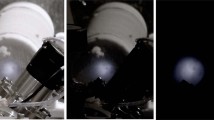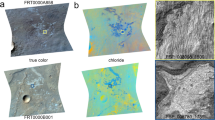Abstract
Remote-sensing data from lunar orbiters have revealed spectral features consistent with the presence of OH or H2O on the lunar surface. Analyses of data from the Moon Mineralogy Mapper spectrometer onboard the Chandrayaan-1 spacecraft have suggested that OH/H2O is recycled on diurnal timescales and persists only at high latitudes. However, the spatial distribution and temporal variability of the OH/H2O, as well as its source, remain uncertain. Here we incorporate a physics-based thermal correction into analysis of reflectance spectra from the Moon Mineralogy Mapper and find that prominent absorption features consistent with OH/H2O can be present at all latitudes, local times and surface types examined. This suggests the widespread presence of OH/H2O on the lunar surface without significant diurnal migration. We suggest that the spectra are consistent with the production of OH in space-weathered materials by the solar wind implantation of H+ and formation of OH at crystal defect sites, as opposed to H2O sourced from the lunar interior. Regardless of the specific composition or formation mechanism, we conclude that OH/H2O can be present on the Moon under thermal conditions more wide-ranging than previously recognized.
This is a preview of subscription content, access via your institution
Access options
Access Nature and 54 other Nature Portfolio journals
Get Nature+, our best-value online-access subscription
$29.99 / 30 days
cancel any time
Subscribe to this journal
Receive 12 print issues and online access
$259.00 per year
only $21.58 per issue
Buy this article
- Purchase on Springer Link
- Instant access to full article PDF
Prices may be subject to local taxes which are calculated during checkout




Similar content being viewed by others
References
Pieters, C. M. et al. Character and spatial distribution of OH/H2O on the surface of the moon seen by M3 on Chandrayaan-1. Science326, 568–572 (2009).
Sunshine, J. M. et al. Temporal and spatial variability of lunar hydration as observed by the deep impact spacecraft. Science326, 565–568 (2009).
Clark, R. N. Detection of adsorbed water and hydroxyl on the moon.Science326, 562–564 (2009).
McCord, T. B., et al. Sources and physical processes responsible for OH/H2O in the lunar soil as revealed by the moon mineralogy mapper (M3). J. Geophys. Res. 116, E00G05 (2011).
Kramer, G. Y., et al. M3 spectral analysis of lunar swirls and the link between optical maturation and surface hydroxyl formation at magnetic anomalies. J. Geophys. Res. 116, E00G18 (2011).
Klima, R., Cahill, J., Hagerty, J. & Lawrence, D. Remote detection of magmatic water in Bullialdus Crater on the Moon. Nat. Geosci.6, 737–741 (2013).
Li, S. & Milliken, R. E. An empirical thermal correction model for Moon Mineralogy Mapper data constrained by laboratory spectra and diviner temperatures. J. Geophys. Res.121, 2081–2107 (2016).
Wöhler, C. A. et al. Temperature regime and water/hydroxyl behavior in the crater boguslawsky on the moon. Icarus285, 118–136 (2017).
Bandfield, J. L. & Edwards, C. S. Derivation of martian surface slope characteristics from directional thermal infrared radiometry. Icarus193, 139–157 (2008).
Bandfield, J. L., Hayne, P. O., Williams, J.-P., Greenhagen, B. T. & Paige, D. A. Lunar surface roughness derived from LRO Diviner Radiometer observations. Icarus248, 357–372 (2015).
Clark, R. N., Pieters, C. M., Green, R. O., Boardman, J. W. & Petro, N. E. Thermal removal from near-infrared imaging spectroscopy data of the Moon. J. Geophys. Res. 116, E00G16 (2011).
Clark, R. N. Spectral properties of mixtures of montmorillonite and dark grains — implications for remote sensing minerals containing chemically and physically adsorbed water. J. Geophys. Res.88, 10635–10644 (1983).
Hapke, B. Theory of Reflectance and Emittance Spectroscopy (Cambridge Univ. Press, Cambridge, 1993).
Milliken, R. E. & Mustard, J. F. Estimating the water content of hydrated minerals using reflectance spectroscopy. I. Effects of darkening agents and low-albedo materials. Icarus189, 550–573 (2007).
Gaddis, L. R., Staid, M. I., Tyburczy, J. A., Hawke, B. R. & Petro, N. E. Compositional analyses of lunar pyroclastic deposits. Icarus161, 262–280 (2003).
Head, J. W. & Wilson, L. Generation, ascent and eruption of magma on the Moon: new insights into source depths, magma supply, intrusions and effusive/explosive eruptions (Part 2: Predicted emplacement processes and observations). Icarus283, 176–223 (2017).
Head, J. W. & McCord, T. B. Imbrian-age highland volcanism on the moon — the Gruithuisen and Mairan domes. Science199, 1433–1436 (1978).
Wilson, L. & Head, J. W. Lunar Gruithuisen and Mairan domes: rheology and mode of emplacement. J. Geophys. Res. 108, E001909 (2003).
Glotch, T. D. et al. Highly silicic compositions on the moon.Science329, 1510–1513 (2010).
Ivanov, M. A., Head, J. W. & Bystrov, A. The lunar gruithuisen silicic extrusive domes: topographic configuration, morphology, ages, and internal structure. Icarus273, 262–283 (2016).
Hemingway, D. J., Garrick-Bethell, I. & Kreslavsky, M. A. Latitudinal variation in spectral properties of the lunar maria and implications for space weathering. Icarus261, 66–79 (2015).
Glotch, T. D. et al. Formation of lunar swirls by magnetic field standoff of the solar wind. Nat. Commun.6, 6189 (2015).
Hood, L. L. & Schubert, G. Lunar magnetic anomalies and surface optical properties. Science208, 49–51 (1980).
Dyar, M. D., Hibbitts, C. A. & Orlando, T. M. Mechanisms for incorporation of hydrogen in and on terrestrial planetary surfaces. Icarus208, 425–437 (2010).
Bradley, J. P. et al. Detection of solar wind-produced water in irradiated rims on silicate minerals. Proc. Natl Acad. Sci. USA111, 1732–1735 (2014).
Poston, M. J. et al. Water interactions with micronized lunar surrogates JSC-1A and albite under ultra-high vacuum with application to lunar observations. J. Geophys. Res.118, 105–115 (2013).
Hibbitts, C. A. et al. Thermal stability of water and hydroxyl on the surface of the Moon from temperature-programmed desorption measurements of lunar analog materials. Icarus213, 64–72 (2011).
Mitchell, E. H. et al. Ultraviolet photodesorption as a driver of water migration on the lunar surface. Planet. Space Sci. 89, 42–46 (2013).
Poston, M. J. et al. Temperature programmed desorption studies of water interactions with Apollo lunar samples 12001 and 72501. Icarus255, 24–29 (2015).
Ichimura, A. S., Zent, A. P., Quinn, R. C., Sanchez, M. R. & Taylor, L. A. Hydroxyl (OH) production on airless planetary bodies: evidence from H+/D+ ion-beam experiments. Earth Planet. Sci. Lett.345, 90–94 (2012).
Farrell, W. M., Hurley, D. M., Esposito, V. J., McLain, J. L. & Zimmerman, M. I. The statistical mechanics of solar wind hydroxylation at the Moon, within lunar magnetic anomalies, and at Phobos. J. Geophys. Res.122, 269–289 (2017).
Farrell, W. M., Hurley, D. M. & Zimmerman, M. I. Solar wind implantation into lunar regolith: hydrogen retention in a surface with defects.Icarus255, 116–126 (2015).
Starukhina, L. Water detection on atmosphereless celestial bodies: alternative explanations of the observations. J. Geophys. Res.106, 14701–14710 (2001).
Saal, A. E. et al. Volatile content of lunar volcanic glasses and the presence of water in the Moon’s interior. Nature454, 192–195 (2008).
McCubbin, F. M. et al. Nominally hydrous magmatism on the Moon.Proc. Natl Acad. Sci. USA107, 11223–11228 (2010).
Greenwood, J. P. et al. Hydrogen isotope ratios in lunar rocks indicate delivery of cometary water to the Moon. Nat. Geosci.4, 79–82 (2011).
Milliken, R. E. & Li, S. Remote detection of widespread indigenous water in lunar pyroclastic deposits. Nat. Geosci.10, 561–565 (2017).
Rivkin, A. S. et al. 3 μm spectrophotometric survey of M- and E-class asteroids. Icarus117, 90–100 (1995).
Barker, M. K. et al. A new lunar digital elevation model from the Lunar Orbiter Laser Altimeter and SELENE Terrain Camera. Icarus273, 346–355 (2016).
Scholten, F. J. et al. GLD100: The near-global lunar 100m raster DTM from LROC WAC stereo image data. J. Geophys. Res. 117, E00H17 (2012).
Keihm, S. J. Interpretation of the lunar microwave brightness temperature spectrum — feasibility of orbital heat flow mapping. Icarus60, 568–589 (1984).
Vasavada, A. R. et al. Lunar equatorial surface temperatures and regolith properties from the Diviner Lunar Radiometer Experiment. J. Geophys. Res. 117 (2012).
Helfenstein, P. & Shepard, M. K. Submillimeter-scale topography of the lunar regolith. Icarus141, 107–131 (1999).
Shepard, M. K., Brackett, R. A. & Arvidson, R. E. Self-affine (fractal) topography: surface parameterization and radar scattering. J. Geophys. Res.100, 11709–11718 (1995).
Smith, B. G. Lunar surface roughness: shadowing and thermal emission. J. Geophys. Res.72, 4059–4067 (1967).
Besse, S. et al. A visible and near-infrared photometric correction for Moon Mineralogy Mapper (M3). Icarus222, 229–242 (2013).
Logan, L. & Hunt, G. R. Emission spectra of particulate silicates under simulated lunar conditions. J. Geophys. Res.75, 6539–6548 (1970).
Henderson, B. G., Lucey, P. G. & Jakosky, B. M. New laboratory measurements of mid-IR emission spectra of simulated planetary surfaces.J. Geophys. Res.101, 14969–14975 (1996).
Donaldson Hanna, K. L. et al. Effects of varying environmental conditions on emissivity spectra of bulk lunar soils: application to Diviner thermal infrared observations of the Moon. Icarus283, 326–342 (2017).
Salisbury, J. W., Murcray, D. G., Williams, W. J. & Blatherwick, R. D. Thermal infrared spectra of the Moon. Icarus115, 181–190 (1995).
Greenhagen, B. T. et al. Global silicate mineralogy of the moon from the diviner lunar radiometer. Science329, 1507–1509 (2010).
Shkuratov, Y. et al. Optical measurements of the Moon as a tool to study its surface. Planet. Space Sci.59, 1326–1371 (2011).
Nicodemus, F. E. Directional reflectance and emissivity of an opaque surface. Appl. Opt.4, 767–775 (1965).
Acknowledgements
We would like to acknowledge funding by the Lunar Reconnaissance Orbiter program and Lunar Data Analysis Program grant NNX16AN63G. Our work benefited from discussions with the LRO Diviner science team, S. Li, and R. Milliken.
Author information
Authors and Affiliations
Contributions
J.L.B. developed the thermal correction model and led the processing and analysis of the M3 and Diviner data. M.J.P. contributed to the interpretation of spectral features and the development of formation mechanism hypotheses. R.L.K. contributed to the spectral interpretation of the M3 data and discussions of petrological sources of OH/H2O. C.S.E. contributed to the development of the thermal and roughness model and assisted with the interpretation of the spectral data sets.
Corresponding author
Ethics declarations
Competing interests
The authors declare no competing financial interests.
Additional information
Publisher's note: Springer Nature remains neutral with regard to jurisdictional claims in published maps and institutional affiliations.
Supplementary information
Supplementary Information
Supplementary figures and tables
Rights and permissions
About this article
Cite this article
Bandfield, J.L., Poston, M.J., Klima, R.L. et al. Widespread distribution of OH/H2O on the lunar surface inferred from spectral data. Nature Geosci 11, 173–177 (2018). https://doi.org/10.1038/s41561-018-0065-0
Received:
Accepted:
Published:
Issue Date:
DOI: https://doi.org/10.1038/s41561-018-0065-0
This article is cited by
-
Formation of lunar surface water associated with high-energy electrons in Earth’s magnetotail
Nature Astronomy (2023)
-
Surface Exospheric Interactions
Space Science Reviews (2023)
-
A solar wind-derived water reservoir on the Moon hosted by impact glass beads
Nature Geoscience (2023)
-
Chang’E-5 samples reveal high water content in lunar minerals
Nature Communications (2022)
-
Evidence of water on the lunar surface from Chang’E-5 in-situ spectra and returned samples
Nature Communications (2022)



